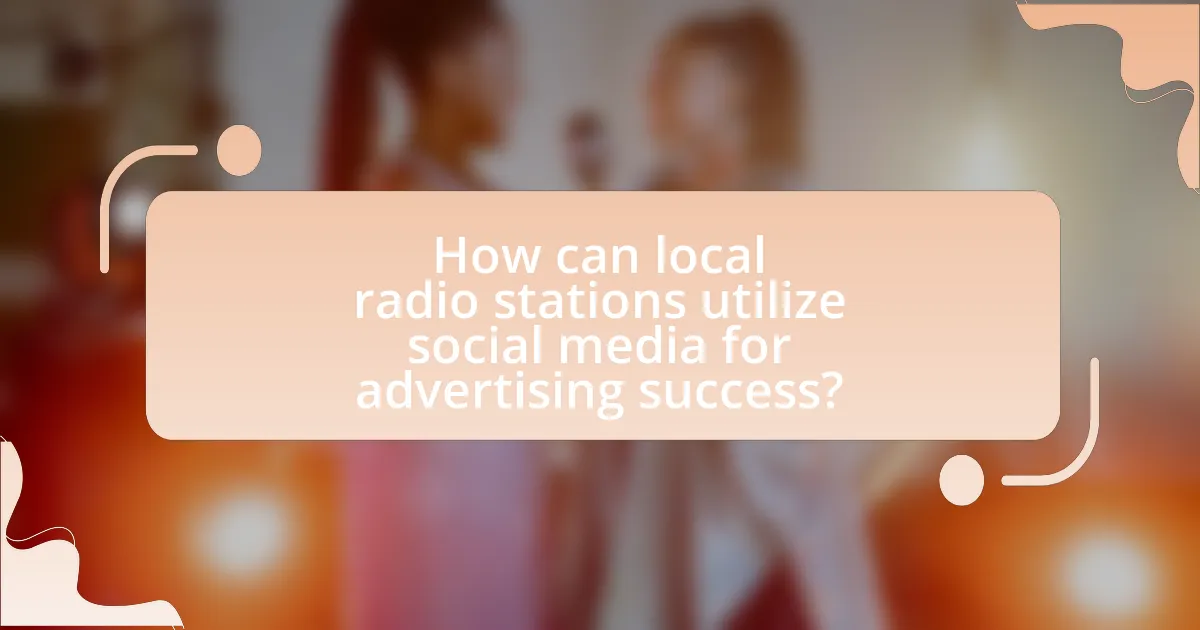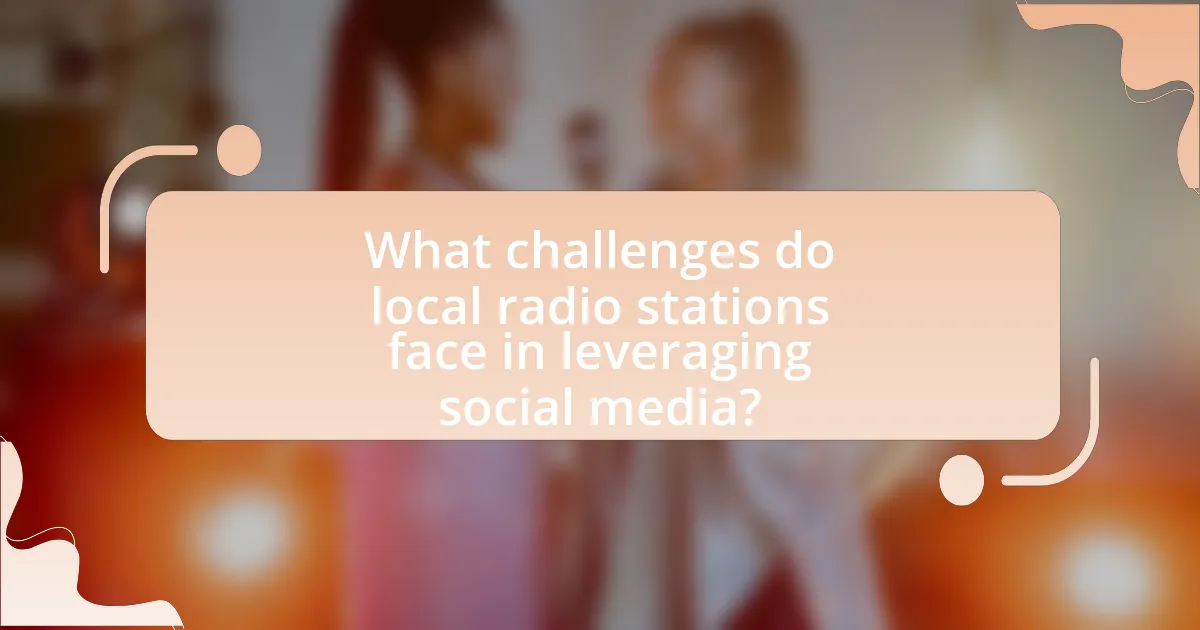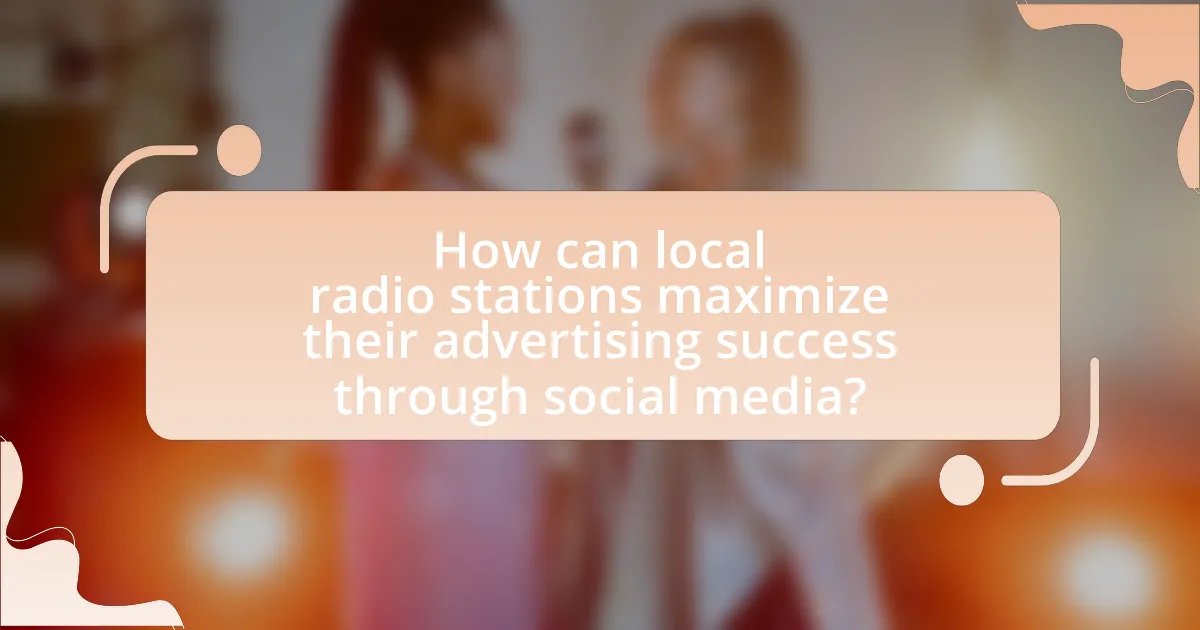Local radio stations can enhance their advertising success by effectively utilizing social media platforms such as Facebook, Instagram, Twitter, and TikTok. The article explores strategies for engaging content creation, targeted advertising, and audience interaction, emphasizing the importance of understanding demographic differences across platforms. It also addresses challenges faced by local stations, such as resource limitations and audience engagement, while providing practical tips for maximizing social media impact. Additionally, successful case studies illustrate how local radio stations can adapt their strategies to different markets, ultimately fostering community connection and increasing brand visibility.

How can local radio stations utilize social media for advertising success?
Local radio stations can utilize social media for advertising success by creating engaging content that resonates with their audience and promotes their on-air programming. By leveraging platforms like Facebook, Instagram, and Twitter, radio stations can share live updates, behind-the-scenes content, and listener interactions, which fosters community engagement and builds a loyal listener base.
Research indicates that 54% of social media users use these platforms to discover new brands, making it essential for radio stations to maintain an active presence. Additionally, targeted advertising on social media allows local stations to reach specific demographics effectively, enhancing their advertising campaigns’ precision and impact.
What are the key social media platforms for local radio stations?
The key social media platforms for local radio stations are Facebook, Instagram, Twitter, and TikTok. These platforms enable local radio stations to engage with their audience, promote content, and share updates effectively. For instance, Facebook allows for community building through groups and event promotion, while Instagram’s visual content can enhance brand identity. Twitter serves as a real-time communication tool for news and updates, and TikTok offers creative opportunities to reach younger demographics through short-form video content. Each platform provides unique features that can be leveraged for advertising success, making them essential for local radio stations.
How does each platform cater to different audience demographics?
Different social media platforms cater to various audience demographics through their unique features and user bases. For instance, Facebook primarily attracts a diverse age range, with significant engagement from users aged 25 to 54, making it suitable for local radio stations targeting a broad audience. Instagram, on the other hand, skews younger, with a majority of users aged 18 to 29, allowing radio stations to connect with a more youthful demographic through visually engaging content. Twitter serves a more news-oriented audience, often comprising professionals and influencers, which can be leveraged for real-time updates and engagement. LinkedIn targets business professionals, making it ideal for radio stations focusing on B2B advertising. Each platform’s user demographics and engagement styles enable local radio stations to tailor their advertising strategies effectively to reach specific audience segments.
What unique features do these platforms offer for advertising?
Social media platforms offer unique features for advertising, including targeted advertising, real-time engagement, and analytics tools. Targeted advertising allows businesses to reach specific demographics based on user data, enhancing the effectiveness of ad campaigns. Real-time engagement enables advertisers to interact with audiences instantly, fostering community and brand loyalty. Additionally, analytics tools provide insights into ad performance, allowing for data-driven adjustments to optimize campaigns. These features collectively enhance the advertising capabilities of local radio stations when leveraging social media for success.
Why is social media important for local radio advertising?
Social media is important for local radio advertising because it enhances audience engagement and expands reach. Local radio stations can utilize social media platforms to promote their content, interact with listeners, and share advertisements, thereby increasing visibility. According to a Nielsen report, 60% of radio listeners also use social media, indicating a significant overlap that local radio can capitalize on to connect with their audience more effectively. This integration allows for real-time feedback and community building, which are essential for local businesses looking to advertise through radio.
How does social media enhance audience engagement?
Social media enhances audience engagement by facilitating real-time interaction and feedback between content creators and their audience. This immediacy allows local radio stations to connect with listeners through comments, shares, and likes, fostering a sense of community. According to a study by the Pew Research Center, 69% of adults in the U.S. use social media, which indicates a vast potential audience for engagement. Furthermore, social media platforms enable targeted advertising, allowing local radio stations to reach specific demographics effectively, thereby increasing listener involvement and loyalty.
What role does social media play in brand visibility for local stations?
Social media significantly enhances brand visibility for local stations by providing a platform for direct engagement with the community. Local stations can share content, promote events, and interact with listeners in real-time, which fosters a sense of connection and loyalty. According to a 2021 survey by the Pew Research Center, 69% of adults in the U.S. use social media, making it an essential tool for reaching a broad audience. By utilizing targeted advertising and organic posts, local stations can increase their reach and visibility, ensuring that their brand remains top-of-mind within the community.
What strategies can local radio stations implement on social media?
Local radio stations can implement strategies on social media by engaging their audience through interactive content, promoting local events, and utilizing targeted advertising. Engaging content, such as polls, contests, and live Q&A sessions, fosters community interaction and increases listener loyalty. Promoting local events allows stations to connect with their audience and support community initiatives, enhancing their local presence. Additionally, targeted advertising on platforms like Facebook and Instagram enables radio stations to reach specific demographics, maximizing their advertising effectiveness. These strategies are supported by the fact that social media engagement can increase brand awareness and listener retention, as evidenced by studies showing that interactive posts generate higher engagement rates compared to standard promotional content.
How can content creation be optimized for social media platforms?
Content creation can be optimized for social media platforms by tailoring content to the specific audience and platform characteristics. This involves using platform-specific formats, such as short videos for TikTok or visually appealing images for Instagram, which align with user preferences. Additionally, incorporating relevant hashtags and engaging calls-to-action can enhance visibility and interaction. Research indicates that posts with images receive 94% more views than text-only posts, highlighting the importance of visual content in social media engagement. Furthermore, analyzing audience insights and engagement metrics allows for continuous refinement of content strategies, ensuring that the content resonates with the target demographic effectively.
What types of advertising campaigns work best on social media?
Engagement-driven advertising campaigns work best on social media. These campaigns focus on interactive content, such as polls, contests, and user-generated content, which encourage audience participation and foster community. According to a study by Sprout Social, posts that generate high engagement can increase brand visibility and loyalty, with 70% of consumers stating they are more likely to engage with brands that respond to their comments. Additionally, visually appealing campaigns, such as video ads and eye-catching graphics, have been shown to capture attention more effectively, with video content generating 1200% more shares than text and images combined, as reported by Wordstream.

What challenges do local radio stations face in leveraging social media?
Local radio stations face several challenges in leveraging social media, including limited resources, audience engagement, and content creation. Limited resources often result in insufficient staff and budget to effectively manage social media platforms, hindering their ability to maintain a consistent online presence. Audience engagement poses another challenge, as local radio stations may struggle to connect with younger demographics who predominantly use social media, leading to a disconnect between traditional broadcasting and digital interaction. Additionally, creating engaging and relevant content that resonates with their audience can be difficult, especially when competing with a vast array of content available online. These challenges collectively impact the effectiveness of local radio stations in utilizing social media for advertising success.
How can local radio stations overcome these challenges?
Local radio stations can overcome challenges by effectively integrating social media into their advertising strategies. By utilizing platforms like Facebook, Instagram, and Twitter, radio stations can engage with their audience in real-time, promote their content, and attract advertisers looking for targeted outreach. Research indicates that 54% of consumers prefer to see ads on social media platforms, highlighting the potential for increased revenue through strategic social media campaigns. Additionally, local radio stations can collaborate with local influencers to expand their reach and credibility, further enhancing their advertising success.
What resources are necessary for effective social media management?
Effective social media management requires a combination of human resources, technology, and content strategy. Human resources include skilled social media managers who understand audience engagement and analytics, as well as graphic designers and content creators to produce visually appealing posts. Technology resources encompass social media management tools like Hootsuite or Buffer for scheduling and analytics, and platforms for monitoring brand mentions and engagement metrics. A well-defined content strategy is essential, which includes a content calendar, audience research, and performance metrics to evaluate success. These elements collectively ensure that social media efforts are targeted, efficient, and measurable, leading to improved advertising success for local radio stations.
How can local stations measure the success of their social media efforts?
Local stations can measure the success of their social media efforts by analyzing key performance indicators (KPIs) such as engagement rates, follower growth, and conversion metrics. Engagement rates, which include likes, shares, comments, and overall interaction with posts, provide insight into how well content resonates with the audience. For instance, a study by Hootsuite found that posts with higher engagement rates typically lead to increased brand awareness and loyalty. Follower growth indicates the expanding reach of the station’s social media presence, while conversion metrics, such as website clicks or event sign-ups, demonstrate the effectiveness of social media in driving desired actions. By regularly tracking these metrics, local stations can assess the impact of their social media strategies and make data-driven adjustments to enhance their advertising success.
What common mistakes should local radio stations avoid on social media?
Local radio stations should avoid inconsistent posting on social media, as it can lead to decreased audience engagement and brand recognition. Regular and timely updates are crucial for maintaining listener interest and fostering community interaction. Additionally, failing to respond to audience comments and messages can create a perception of unapproachability, which may alienate potential listeners. Research indicates that brands that engage with their audience on social media see a 20-40% increase in customer loyalty. Lastly, neglecting to analyze social media metrics can result in missed opportunities for improvement and growth, as understanding audience preferences is essential for effective content strategy.
How can poor engagement be addressed and improved?
Poor engagement can be addressed and improved by implementing targeted social media strategies that resonate with the audience. Local radio stations can enhance engagement by creating interactive content, such as polls and live Q&A sessions, which encourage listener participation. Research indicates that interactive posts can increase engagement rates by up to 50%, as they foster a sense of community and connection among listeners. Additionally, analyzing audience feedback and preferences through social media analytics allows stations to tailor their content more effectively, ensuring it aligns with listener interests and needs.
What are the risks of not having a social media presence?
Not having a social media presence poses significant risks for local radio stations, including reduced audience engagement and diminished brand visibility. Without social media, radio stations miss opportunities to connect with listeners, share content, and promote events, leading to a potential decline in listener loyalty. According to a 2021 survey by the Pew Research Center, 69% of adults in the U.S. use social media, indicating that a substantial portion of the audience expects to interact with brands online. Additionally, the lack of social media presence can hinder advertising revenue, as businesses increasingly seek to partner with stations that have a robust online following to reach their target demographics effectively.

How can local radio stations maximize their advertising success through social media?
Local radio stations can maximize their advertising success through social media by creating targeted content that engages their audience and promotes local businesses. By utilizing platforms like Facebook, Instagram, and Twitter, radio stations can share promotional posts, live updates, and interactive content that resonates with their community. Research indicates that 73% of marketers believe that their efforts through social media marketing have been “somewhat effective” or “very effective” for their business (Buffer, 2021). This engagement not only increases brand visibility but also fosters a sense of community, encouraging local businesses to invest in advertising with the station. Additionally, leveraging user-generated content and running contests can further enhance audience interaction, leading to increased advertising revenue.
What best practices should local radio stations follow for social media advertising?
Local radio stations should prioritize audience engagement, consistent branding, and targeted content in their social media advertising strategies. Engaging with listeners through interactive posts, polls, and live Q&A sessions fosters community and loyalty. Consistent branding across all platforms ensures that the station’s identity is recognizable, which is crucial for building trust. Additionally, creating targeted content that resonates with specific demographics enhances the effectiveness of advertising campaigns. According to a study by the Pew Research Center, 69% of adults use social media, making it a vital channel for reaching potential listeners and advertisers.
How can local radio stations effectively target their audience on social media?
Local radio stations can effectively target their audience on social media by utilizing demographic data and engaging content tailored to their listeners’ preferences. By analyzing listener demographics such as age, location, and interests, radio stations can create targeted ads and posts that resonate with specific audience segments. For instance, a study by the Pew Research Center indicates that 69% of adults use social media, making it a vital platform for reaching diverse age groups. Additionally, local radio stations can enhance engagement by sharing behind-the-scenes content, hosting live Q&A sessions, and promoting local events, which fosters a sense of community and encourages listener interaction. This approach not only increases visibility but also strengthens listener loyalty, as evidenced by a Nielsen report showing that 60% of social media users follow brands to stay updated on promotions and events.
What role does analytics play in refining social media advertising strategies?
Analytics plays a crucial role in refining social media advertising strategies by providing data-driven insights that inform decision-making. By analyzing metrics such as engagement rates, click-through rates, and audience demographics, advertisers can identify which content resonates most with their target audience. For instance, a study by HubSpot found that businesses using data analytics in their marketing strategies see a 5-10% increase in ROI. This evidence underscores the importance of leveraging analytics to optimize ad placements, tailor messaging, and enhance overall campaign effectiveness.
What are some successful case studies of local radio stations using social media?
Successful case studies of local radio stations using social media include WNYC in New York City and KCRW in Santa Monica. WNYC effectively utilized Twitter to engage listeners during live broadcasts, resulting in increased audience interaction and a 20% rise in social media followers over a year. KCRW leveraged Instagram to showcase behind-the-scenes content and promote events, leading to a 30% increase in event attendance and a significant boost in listener engagement. These examples demonstrate how local radio stations can enhance their reach and community connection through strategic social media use.
What lessons can be learned from these successful examples?
Successful examples demonstrate that local radio stations can effectively engage their audience by integrating social media into their advertising strategies. These stations can enhance listener interaction and brand loyalty through consistent and authentic communication on platforms like Facebook and Instagram. For instance, a study by the Pew Research Center found that 69% of adults use social media, indicating a significant opportunity for radio stations to reach their audience where they are most active. Additionally, successful campaigns often utilize user-generated content, which fosters community involvement and increases the perceived value of the station’s brand. By analyzing these strategies, local radio stations can learn the importance of adaptability, audience engagement, and leveraging digital platforms to maximize their advertising success.
How can these strategies be adapted to different local markets?
Strategies for leveraging social media for advertising success can be adapted to different local markets by analyzing local demographics, cultural preferences, and media consumption habits. For instance, radio stations can tailor their content and advertising messages to resonate with the specific interests and values of the local audience, ensuring relevance and engagement. Research indicates that localized content increases listener loyalty; a study by the Pew Research Center found that 64% of local radio listeners prefer content that reflects their community. Additionally, utilizing local influencers and community events in social media campaigns can enhance visibility and connection with the target market, as local endorsements often carry more weight than national campaigns.
What practical tips can local radio stations implement for social media success?
Local radio stations can achieve social media success by consistently engaging their audience through interactive content, such as polls and live Q&A sessions. This approach fosters community involvement and encourages listener participation, which can lead to increased loyalty and reach. Additionally, utilizing analytics tools to track engagement metrics allows stations to refine their content strategy based on audience preferences, ensuring that posts resonate effectively. According to a study by the Pew Research Center, 69% of adults in the U.S. use social media, highlighting the importance of a strong online presence for local radio stations to connect with their audience.